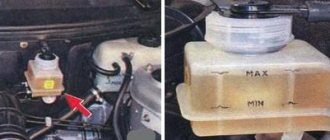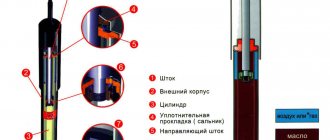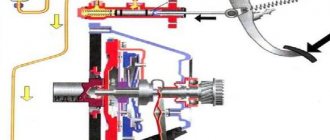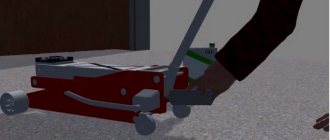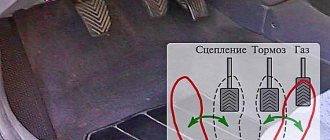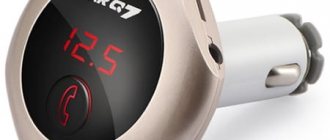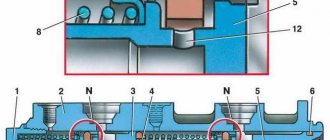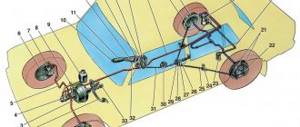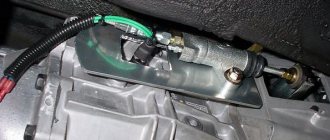If you do not carry out preventive maintenance on your car in a timely manner, this can lead to sudden breakdown of components and even accidents. You need to pump the clutch on a VAZ at least once a year, but if you notice clear signs of bubbles in the brake fluid, then you need to do it now. In this article you will learn how to determine that there are bubbles in your brake fluid, and most importantly, you will find instructions for bleeding the clutch on a VAZ. This article is ideal for models 2106, 2101, 2107, and is also applicable to 2104. Even if you are the owner of another VAZ model, read this article, look at the principles of clutch bleeding and try to apply them to your car.
Dismantling the hydraulic drive
To perform the operation we will need:
- container for operating fluid and a large-volume syringe.
- set of wrenches and sockets;
- screwdriver and pliers.
The order of work is as follows:
- Brake fluid is pumped out from the expansion tank of the master cylinder of a VAZ 2107 car using a syringe. A rubber tube is disconnected from the drive, from which the remains are also poured into the prepared container. If liquid gets on paint surfaces, they must be wiped with a damp cloth.
- Using an open-end wrench set to “10”, unscrew the fitting of the pipeline connecting the main and working hydraulic drives.
- Using a “13” socket and an extension adapter, unscrew the nuts holding the assembly to the engine compartment panel.
- To remove the master cylinder from the studs, simply press the clutch pedal, this will move it out of place, after which you can pull it out by hand.
The work on removing the unit is completed, and you can begin installing the spare part.
Hydraulic drive installation
Replacing a mechanism involves purchasing it in a retail network or via the Internet. Installation work is performed in the following sequence:
- The clutch master cylinder of the VAZ 2107 is put on the studs and pushed all the way to the base.
- The nuts are screwed onto the fasteners and tightened with a wrench to “13”.
- The union nut of the pipeline laid to the working hydraulic drive is screwed into the main cylinder.
- The rubber tube is connected to a plastic connecting element and secured with a clamp.
- The expansion tank is filled with brake fluid, which enters the main and slave cylinders of the clutch through tubes. Replacing the fluid in the system is mandatory due to wear products.
Upon completion of installation of parts, it is necessary to inspect and check the tightness of the nuts. Replacing the main or working clutch drive of a VAZ 2107 car ends with bleeding the system.
VAZ 2107 clutch: device
The “Seven” has a dry single-disc clutch. The clutch hydraulic master cylinder is located directly under the pedal, when pressed, the pusher moves, acting on the master cylinder piston, creating pressure. The brake fluid that fills the hydraulic drive is squeezed out and flows into the working cylinder.
The piston of the working cylinder is connected to the clutch fork by a pusher. When you press the pedal, the latter moves the fork, it displaces the release bearing and separates the support and pressure discs. As a result, the torque from the crankshaft flywheel is no longer transmitted to the gearbox and it becomes possible to change gear.
If the clutch unit malfunctions, when you press the pedal, the gearbox shaft continues to rotate and changing gears becomes difficult or even impossible. If the clutch is adjusted incorrectly, the discs may slip, which is accompanied by accelerated wear.
You cannot continue to drive a car with a faulty clutch - both the clutch discs and the gearbox may be damaged. Therefore, at the first sign of a malfunction, you should start repairing and adjusting it.
When pumping is required
The system can be pumped quickly and efficiently even if you do not have extensive experience in such matters.
There are several reasons why a hydraulic clutch may become filled with excess air. The main ones include:
One-way road: we analyze traffic rules, signs and fines for violation
Category: Traffic rules
- carrying out diagnostic measures;
- performing repair work;
- use of low-quality spare parts;
- poor tension of connecting elements;
- faults and cracks in pipelines;
- initially defective clutch due to the fault of the manufacturer;
- natural wear processes;
- aggressive use of the clutch pedal;
- mechanical damage;
- consequences of improper repair of clutch-related components, etc.
Before you start pumping alone, it is strongly recommended to find the cause of the problem. It's one thing if it's just a standard procedure after repairs.
Things are completely different if there is damage in the system, some defects or malfunctions. Is it necessary to start pumping under such circumstances? No. The procedure will be pointless. Don't waste your energy and precious time.
First, fix the problem, make sure that the fluid level in the hydraulic system is normal, and only then start pumping yourself.
There are several characteristic signs that indicate that the clutch needs to be pumped:
- when driving, the car begins to jerk actively;
- when you press the clutch pedal you feel a beat;
- it is not possible to fully depress the pedal;
- the effect of the depressed clutch occurs only after 1-3 presses;
- excessive force has to be applied to the pedal;
- the car reacts inadequately to gear shifting;
- traces of leaking hydraulic fluid are formed, etc.
If a car's clutch does not work properly, continuing to operate it is potentially very dangerous. Therefore, be sure to fix the identified malfunction.
No one forbids you to go to a car service center, where technicians will quickly bleed the system. But if there are no clutch failures, this procedure can be easily performed independently. You just need hands, feet and a small set of tools.
Replacing the clutch master cylinder VAZ 2107
The simplest way to repair a VAZ 2107 clutch is to change the worn cylinders (main and slave). Their price is low, and the labor intensity of the operation is much lower than when carrying out repairs. Therefore, car owners often prefer to replace rather than repair clutches.
Let's start by replacing the master cylinder. The order of operations is as follows:
- Drain the brake fluid from the clutch reservoir into another container. This can be conveniently done using a syringe.
- Loosen the clamp and remove the hose from the master cylinder fitting.
- Unscrew the fitting of the metal tube going from the master cylinder to the slave cylinder and disconnect the tube.
- Using a 13mm wrench or a socket with an extension, unscrew the two nuts securing the master cylinder to the body bulkhead and remove the master cylinder.
The new clutch master cylinder can now be installed. Before doing this, you should check the condition of the flexible hose of the clutch reservoir. If it cracks at the end, it needs to be trimmed slightly or replaced with a new one.
When installing a new cylinder, it is necessary to ensure that the clutch pedal drive rod fits inside the cylinder. For convenience, you can ask your partner to slightly press the clutch pedal and hold it. Then follows:
- Install the master cylinder onto the studs and tighten the nuts.
- Attach and tighten the metal tube fitting.
- Place the pipe from the clutch reservoir and tighten the clamp.
- Fill the reservoir with brake fluid, following the level marks.
Replacing the clutch slave cylinder VAZ 2107
Removal of the working cylinder should be done from the inspection hole or using a lift. The order of operations is as follows:
- Remove the return spring from the slave cylinder bracket.
- Unscrew the fitting of the tube coming from the master cylinder. To prevent brake fluid from leaking from it, you can put a cap on it, removed from the cylinder bleeder fitting, or direct it into a container prepared in advance.
- Unscrew the two bolts connecting the slave cylinder to the gearbox and remove them together with the plate.
- Remove the clutch slave cylinder.
The new working cylinder is installed in the reverse order of removing the old one.
After replacing any of the cylinders, the hydraulic drive system must be pumped. The work must be carried out together with a partner. This is done like this:
- Place a hose on the fitting of the working cylinder and immerse its end in a prepared container for brake fluid.
- Depress the clutch.
- Unscrew the fitting on the working cylinder 1 turn.
- Wait until air bubbles stop coming out and tighten the fitting.
- Repeat the operation until air stops coming out of the fitting. At the same time, monitor the fluid level in the clutch reservoir.
- Tighten the fitting and put on the cap.
There are several ways to bleed the clutch on a VAZ 2107, here is a video about the most popular ones
Tuned sports clutch
In motor sports, which is a kind of testing ground for the development and implementation of innovations in vehicle components and mechanisms, an increased load is applied to the special clutch. After all, this unit is operated when rotating at an angular speed of 6-10 thousand rpm and at the maximum power values of the power unit.
At the same time, the impact on the drive pedal increases, which creates some problems in the speed of gearbox shifting. Therefore, components such as Kevlar alloy, ceramics or polymer carbon are used as friction linings for the drive type disc. Each type of such friction compounds has its own advantages and disadvantages.
Ceramics does not heat up and withstands large impacts, but it requires the creation of high clamping force and has a reduced friction force. Carbon has high resistance to the mating surface, low material density and high heat resistance. Kevlar alloy has increased wear resistance, heat resistance and at the same time has a reduced friction index.
Of course, no one will dispute the importance of the friction clutch in the vehicle control system. Simple procedures for setting up this unit will significantly reduce the risk of wear of parts. Skills in bleeding the hydraulic drive will not be superfluous, because any intervention in the system, be it replacing the working cylinder or a drop in the fluid level in the drive reservoir, leads to airing of the system.
VAZ 2107 clutch repair
Repairing clutch cylinders is somewhat more difficult than replacing them, but much cheaper.
Once the cylinders are removed, disassembly can begin. Let's start with the master cylinder:
- Use a thin screwdriver to remove the retaining ring.
- Remove the fitting and gasket.
- Remove the boot by prying it off with a screwdriver.
- Unscrew the cylinder plug using a 22mm wrench.
- Pull out the retaining ring and use a screwdriver to remove the inside of the cylinder.
To restore the master cylinder, the rubber seals must be replaced. It is also necessary to check the condition of the spring, the inner surface of the cylinder and the piston. If there are burrs or damage, parts must be replaced.
Before assembly, parts should be thoroughly cleaned and dried. It is unacceptable for gasoline or oil to get inside the cylinder - they destroy the rubber seals.
Assembly is carried out in the reverse order of disassembling the cylinder.
The clutch slave cylinder, despite some design features, is repaired in the same way as the main one.
After repairing the cylinders and installing them in place, it is necessary to bleed the hydraulic clutch drive.
Replacing the clutch master cylinder on a VAZ-2104-2107
The main purpose of the clutch master cylinder is that it transmits force to the slave cylinder from the clutch pedal using working fluid.
If the master cylinder is faulty, vehicle control will be impaired and it will be impossible to disconnect the transmission from the engine.
How to determine if the clutch master cylinder is faulty:
- Periodically check the level of working fluid in the tank. A sharp decrease in it will indicate a system malfunction;
- check for leaks in the main and working cylinder housings;
- failure of the clutch pedal, which occurs due to the entry and accumulation of air in the clutch system;
- underpressure of the pedal and vibration of the gear shift lever.
Main types of faults:
- there is a leak in the master cylinder;
- cuff wear;
- piston wear;
- the inside of the case is damaged (chips, scratches, etc.);
- For all classics of the Auto VAZ family, the clutch device is the same, including for 2107. The sequence of actions is the same.
There are two ways to eliminate a malfunction of the master cylinder - replacement with a new one and repair. What can be repaired:
- replace rubber cuffs;
- frame.
These actions do not always lead to the desired effect, especially on an old car with decent mileage. It is recommended to replace the master cylinder with a new one. Its cost is not high, approximately from 450 to 500 rubles. It's better to buy the original.
Preparatory work
The clutch pedal is connected to the clutch master cylinder through a rod. The same rod acts as a piston in this cylinder. There is also a working cylinder - it is installed on the clutch housing. The piston of this cylinder is connected to the release fork.
The force from the driver's foot is transmitted through fluid, so the clutch cylinders are connected to each other by a pipeline.
Fluid is supplied to the master cylinder from the reservoir. The working element is ordinary brake fluid.
It all works like this: the driver presses the clutch pedal, the rod enters the master cylinder and pushes the fluid out of it.
To prevent the liquid from flowing back into the tank, the piston closes the supply fitting from the tank.
Since the fluid is not compressed, it moves through the pipeline and begins to press on the piston in the working cylinder. This piston comes out and pushes the fork, which acts on the release bearing.
When the pedal is released, the fork spring pushes the piston back into the slave cylinder and the fluid returns to the master cylinder.
This scheme seems simple, but may not always be reliable. If air gets inside the drive system, the efficiency of the clutch will decrease.
Air bubbles in the system will be compressed when pressure arises, this will lead to the fact that the full force will not be transmitted.
Because of this, even with the pedal fully depressed, the output of the working cylinder rod will be incomplete, the fork will not fully depress the bearing - as a result, the clutch “drives”.
Any car repair procedure must begin with the preparation of the necessary tools and materials. This procedure is no exception.
To bleed the clutch system you will need:
- something to hold the clutch pedal in place. This will be needed if you bleed the system without an assistant;
- a transparent rubber hose that you will connect to the fitting. The diameter of the hose must match the model of your car, so you need to select it individually. If you don’t have a transparent one, you can take a regular hose, but this way you won’t be able to control the process of air bubbles leaving the system;
- hydraulic clutch fluid;
- the container into which it will be drained from the system;
- set of tools. It should be found in the trunk of every car (the set includes a screwdriver, keys, pliers, and so on).
clutch bleeding tools
To get high-quality and quick results, it is better to invite an assistant to do the work. It’s a good idea if your assistant is familiar with the specifics of the pumping procedure.
How to adjust the clutch?
You can familiarize yourself with the features of this process here. You may also be interested in our article on replacing the clutch master cylinder.
Before performing each repair procedure, preparatory work must be carried out. Check the fluid level first. You need to make sure that its quantity does not deviate too much from the norm. If necessary, add a little fluid to the recommended value (there are special marks on the body of the expansion tank indicating the permissible minimum and maximum). Then remove any dirt or dust that has accumulated on the surface of the protective cap.
The slave cylinder is a complex mechanism that includes a rod from the clutch pedal. This rod is located under the expansion tank and is mounted next to the brake cylinder on the driver's side. You need to remove the cap installed on the top of the air inlet valve. Then place the rubber hose onto the valve stem.
It is possible to do a similar procedure without a hole, but for this you will need an overpass. By following these instructions, people who have virtually no experience working with cars will be able to do the bleeding procedure correctly.
Replacement
The cost of this type of work in a car service starts from 550 rubles. But for most car enthusiasts, this operation is not so difficult to perform on their own.
- new GVC;
- brake fluid;
- set of wrenches with extension;
- syringe or rubber bulb.
- Pump out the fluid from the hydraulic drive reservoir using a syringe or rubber bulb.
- Remove the expansion tank and move it to the side so that it does not interfere with work.
- Unscrew the tube with a 13mm wrench. Move it a little.
- Loosen the clamp and disconnect the rubber hose that goes from the tank to the cylinder.
- Unscrew the two nuts with a 13mm socket wrench and an extension.
- Remove the master cylinder from the studs.
- Replace the GCS with a new one.
- Reassemble everything in reverse order.
Bleeding the clutch
The replacement has been made, but you should not hit the road without bleeding the clutch system. The process is similar to bleeding the brakes and is carried out in the following sequence:
- Brake fluid is poured into the reservoir.
- A hose is put on the master cylinder fitting, the other end is lowered into a bottle filled with liquid. This will show how air leaves the system during the pumping process.
- The operation requires an assistant. One sits in the car and presses the clutch pedal 5-6 times on command, after which he leaves it pressed. The second one opens the fitting until the release of air stops. This is done several times until all air is removed from the clutch system.
- Tighten the fitting and add fluid to the reservoir.
Preparing to bleed the clutch
Clutch operation
Bleeding the clutch is an integral part of car care. All methods for performing such work are, in general, similar and do not require special skills and expensive tools, so you can carry out such an operation yourself in a short time. Many people know this, but not everyone knows how to bleed the clutch. There are 2 types of clutch: mechanical and hydraulic. It is the second type that needs more careful care and regular pumping.
The clutch is pumped at least once every 1.5-2 years, depending on the quality of its operation during this time. This is also a great time to inspect the main parts of the transmission, hydraulic lines, drive, flywheel and some other parts. If you find any damage, you should immediately begin repairs. Before bleeding the clutch, it is advisable to adjust it. It is done by tightening or unscrewing the nut on the cylinder rod.
Removing and replacing the VAZ 2107 clutch master cylinder
Welcome, friends, to the DIY auto repair website. From today's article you will learn how to replace the VAZ 2107 clutch master cylinder yourself, how to bleed it, and what malfunctions there are.
Clutch master cylinder VAZ 2107
On all classic cars, the design of the clutch master cylinder is the same, so this instruction is suitable for different car models, the sequence of actions is as follows: removal, repair, installation, bleeding.
Over time, many vehicle components become unusable and the clutch master cylinder is no exception, so first let’s look at what malfunctions it has.
Possible malfunctions of the clutch master cylinder:
- Master cylinder leaking.
- Wear of rubber cuffs.
- Cylinder piston wear.
- Damage to the interior of the case (scratches, shells).
These are the main failures of the VAZ 2107 clutch master cylinder and there are two options here, repair or replacement.
The repair consists of replacing the rubber cuff, as well as the piston, if it has worn out or any defects; in rare cases, the cylinder (body) itself is changed, but this is only if its inner surface is damaged.
All these repair actions, to be honest, are not always effective, especially if the cylinder has never been changed, so if the car is already quite old, it is better and more reliable to replace the clutch cylinder completely.
What parts and tools are needed
After you have placed your VAZ-2107 on the inspection groove, it is important to prepare a list of required parts and tools. Without them, it will be impossible to carry out the work. So, you will need:
- eight wrench;
- TJ, or brake fluid;
- hose up to one meter long;
- some kind of container where you can drain the brake fluid, preferably transparent.
Then you can proceed directly to the pumping process. To do this you will need:
- Open-end wrench or socket wrench 8;
- Container for draining (with a small amount of liquid);
- New fluid;
- Silicone transparent tube;
- Rags.
This is all the required equipment.
An interesting fact is that with identically used drives on different “Classic” models, the bleeding process is different, so methods for pumping a hydraulic drive on VAZ-2106 and VAZ-2107 vehicles will be described below.
Replacing the VAZ 2107 clutch master cylinder, simply and quickly
Replacing the clutch master cylinder does not present any difficulties, the main thing is that your hands grow from the right place and you have the necessary tools.
What you need to replace the cylinder:
- New cylinder.
- Brake fluid.
- Keys.
So, let's get started, first you need to take the brake fluid from the reservoir, this can be done using a rubber bulb or a regular medical syringe. Also, don’t forget to read the article on replacing brake fluid yourself.
Next, you need to remove the expansion tank and put it aside, otherwise it will simply not be convenient to carry out further repair work.
Next you need to unscrew the metal tube with a thirteen key and move it carefully to the side, then disconnect the rubber hose that goes from the tank to the cylinder, as in the photo below.
Now you can safely unscrew the clutch master cylinder; it is attached to two thirteen nuts; it is better to unscrew it with a socket wrench with an extension (extension), after which all that remains is to remove the cylinder from the studs. Installing the new one is done in reverse order.
Tools for leveling
As with any procedure, before starting work, you need to prepare the necessary tools and materials.
To bleed the system, you need to prepare:
- a set of standard tools (wrenches, pliers, screwdrivers, etc.), which are usually used during repair work;
- container into which the brake fluid will be drained;
- new brake fluid;
- a rubber hose that will connect to a fitting of the appropriate diameter. It is desirable that the hose be transparent, then it is easier to control the air outlet;
- any device with which you can fix the pedal if there is no assistant and you do the work yourself.
In order to carry out all the work efficiently, it is better to call in assistants, preferably someone who knows how to bleed the clutch.
How to bleed the clutch master cylinder
If you know how to bleed the brakes of a VAZ 2107, then bleeding the clutch will not be difficult for you either.
We fill the reservoir with brake fluid, put a hose on the fitting located on the clutch slave cylinder and lower it into the bottle, pouring a little liquid into it, so you can clearly see how the air bubbles will come out.
This whole procedure is done by two people, one presses the clutch pedal, the other unscrews and tightens the fitting on command until the release of air stops.
We press the pedal five, six times and keep the pedal pressed, the assistant unscrews the fitting on the working clutch and the liquid with air goes into the bottle, after which he tightens the fitting.
We release the pedal and repeat the process described above several times until all the air has left the system, while not forgetting to add fluid to the tank. That's it, have a good trip and no breakdowns.
Bleeding the clutch on a VAZ 2101-VAZ 2107
Clutch sometimes happens that some units in the system have to be changed, but this mainly concerns the clutch drive cylinders, after replacing or simply removing them, the clutch hydraulic drive must be pumped, and if this is not done, then when you press the pedal the clutch itself simply will not work turn off completely, and the pedal travel will be very light. The clutch drive must also be pumped if the brake fluid level in the clutch reservoir has reached its minimum and gone even lower than the mark, because in this case air gets into the hydraulic drive and the clutch pedal, which is pressed all the way, may not fully disengage the clutch, Read more about when you need to bleed the clutch hydraulic drive just below!
To bleed the clutch you will need to stock up on: Firstly, new brake fluid that has not been used before, as well as a small rubber hose of about “0.5 or 1” meter in order to carry out the bleeding itself, as well as a wrench “ 8" and a container into which you will drain the used brake fluid with bubbles from the clutch reservoir!
What part is used for pumping and where is this part installed?
Bleeding is carried out only through a fitting that is specifically needed for bleeding the clutch on a car, and this fitting is located on the clutch slave cylinder, which in turn can be very easily seen by looking under the bottom of the car, or by looking from above into the engine compartment. (For a more detailed location of the clutch slave cylinder, see the article entitled: “Replacing the slave cylinder”)
Symptoms and causes of malfunction
There are not so many symptoms of air in the clutch hydraulic drive - difficult gear shifting, crunching of gear teeth when shifting, especially when engaging reverse gear, weakening of the effort to depress the clutch pedal.
Often the cause of airing is a drop in the working fluid level below the minimum value; in this case, air enters the main cylinder through the fitting.
It is possible that liquid began to leak from the system due to loose connections of the pipelines, or their damage; a leak may appear from under the cylinder sealing rings due to wear.
There may even be an option when the hole in the tank lid is clogged. This hole is needed to equalize the pressure in the tank.
And if it becomes clogged inside the system, a vacuum occurs during operation, causing air to penetrate through the sealing rings.
Well, of course, after repair work related to the clutch and its drive, the system will be aired.
To restore the drive's functionality and remove air bubbles, the system should be bled.
This operation is in many ways similar to bleeding the brake system. But before starting work, the cause of airing should be identified.
Therefore, before starting work, you should carefully inspect all drive elements for leaks. If any are found, they must first be eliminated.


